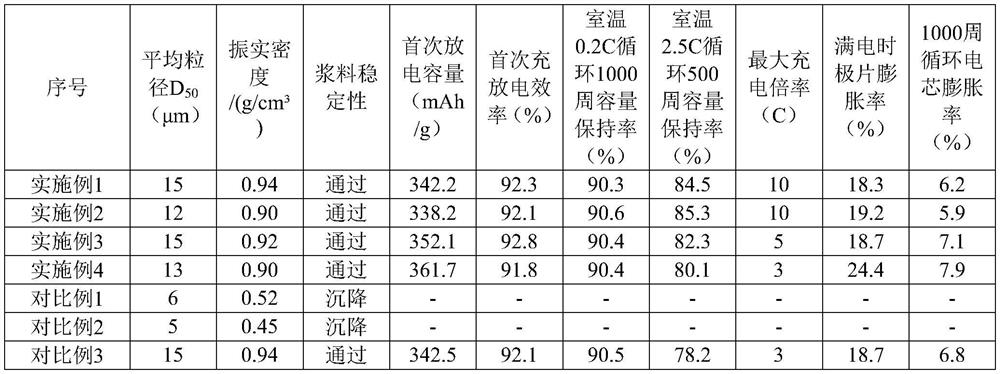Preparation method of high-magnification graphite negative electrode material for lithium ion power battery
A technology of graphite negative electrode and graphite tailing material, applied in battery electrodes, graphite, negative electrode and other directions, can solve the problems of increasing cost pressure of enterprises, small particle size of tailing material, large specific surface area, etc., achieving good isotropy, charging and discharging High rate, good charge and discharge performance
- Summary
- Abstract
- Description
- Claims
- Application Information
AI Technical Summary
Problems solved by technology
Method used
Image
Examples
preparation example Construction
[0046] The preparation method of the present invention will be described in further detail below with reference to specific examples. It should be understood that the following examples are only for illustrating and explaining the present invention, and should not be construed as limiting the protection scope of the present invention. All technologies implemented based on the above content of the present invention are covered within the intended protection scope of the present invention.
[0047] The experimental methods used in the following examples are conventional methods unless otherwise specified; the reagents, materials, etc. used in the following examples can be obtained from commercial sources unless otherwise specified.
Embodiment 1
[0049] (1) Phenolic resin and petroleum coke tailings (D 50 3 μm) into the mixer according to the mass ratio of 16:100, adjust the rotation speed to 240r / min, and mix for 1.5 hours to obtain the first precursor.
[0050] (2) Compress the first precursor into powder and fill it into the rubber mold of the isostatic pressing molding machine. Through high-frequency electromagnetic vibration, the first precursor is compacted. After compaction, vacuumize and discharge the space between the first precursor particles. Put the air into a high-pressure container filled with water, pressurize to 120MPa, heat to 150°C, keep the pressure for 3h, cool to room temperature and press into a block.
[0051] (3) Break up and reshape the block in step (2) to obtain the second precursor (D 50 8μm, tap density 0.65g / cm 3 ).
[0052] (4) The second precursor and asphalt were mixed according to the mass ratio of 100:10, then placed in a fusion machine, fused and granulated at 700°C under nitrogen...
Embodiment 2
[0056] (1) Pitch and pitch coke tailings (D 50 1 μm) was added into the mixer according to the mass ratio of 18:100, the speed was adjusted to 250r / min, and mixed for 3.0 hours to obtain the first precursor.
[0057] (2) Compress the first precursor into powder and fill it into the rubber mold of the isostatic pressing molding machine. Through high-frequency electromagnetic vibration, the first precursor is compacted. After compaction, vacuumize and discharge the space between the first precursor particles. Put the air into a high-pressure container filled with water, pressurize to 130MPa, heat to 120°C, keep the pressure for 3h, cool to room temperature and press into a block.
[0058] (3) breaking up and shaping the agglomerates of step (2) to obtain the second precursor (D 50 6μm, tap density 0.56g / cm 3 ).
[0059] (4) The second precursor and asphalt were mixed according to the mass ratio of 100:15, then placed in a fusion machine, fused and granulated at 700°C under ni...
PUM
| Property | Measurement | Unit |
|---|---|---|
| Tap density | aaaaa | aaaaa |
| Tap density | aaaaa | aaaaa |
| Tap density | aaaaa | aaaaa |
Abstract
Description
Claims
Application Information
 Login to View More
Login to View More - Generate Ideas
- Intellectual Property
- Life Sciences
- Materials
- Tech Scout
- Unparalleled Data Quality
- Higher Quality Content
- 60% Fewer Hallucinations
Browse by: Latest US Patents, China's latest patents, Technical Efficacy Thesaurus, Application Domain, Technology Topic, Popular Technical Reports.
© 2025 PatSnap. All rights reserved.Legal|Privacy policy|Modern Slavery Act Transparency Statement|Sitemap|About US| Contact US: help@patsnap.com

